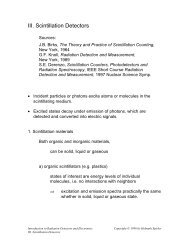Introduction to radiation-resistant semiconductor devices and circuits
Introduction to radiation-resistant semiconductor devices and circuits
Introduction to radiation-resistant semiconductor devices and circuits
Create successful ePaper yourself
Turn your PDF publications into a flip-book with our unique Google optimized e-Paper software.
FIGURE 8. Detec<strong>to</strong>r preamplifier illustrating the use of current-mirror biasing <strong>to</strong><br />
maintain the operating current of the input transis<strong>to</strong>r independent of MOSFET<br />
threshold shifts during ir<strong>radiation</strong><br />
or rendered irrelevant by AC coupling. The operating voltage <strong>and</strong> the gate voltages<br />
of the cascode transis<strong>to</strong>rs Q2 <strong>and</strong> Q3 must be chosen somewhat higher than<br />
for unirradiated operation <strong>to</strong> accommodate the threshold shifts, so overall power<br />
dissipation will be somewhat higher. Techniques of this type can provide <strong>radiation</strong><strong>resistant</strong><br />
amplifiers with <strong>radiation</strong>-soft transis<strong>to</strong>rs.<br />
In general, the use of fully differential circuitry <strong>and</strong> current mirrors yields<br />
circuitry whose operating point relies primarily on relative device matching.<br />
(40,26,28) Changes in threshold voltages or current gain in adjacent <strong>devices</strong> tend<br />
<strong>to</strong> track after <strong>radiation</strong> damage, so the circuit will maintain its operating point.<br />
Circuitry should also be designed <strong>to</strong> minimized single-point failure modes. Failure<br />
of common bias networks will cause all associated circuitry <strong>to</strong> fail. Local biasing<br />
with highly parallel architectures reduces these problems These design principles<br />
have been applied <strong>to</strong> 64 <strong>and</strong> 128 channel bipolar transis<strong>to</strong>r integrated <strong>circuits</strong> for<br />
the readout of strip detec<strong>to</strong>rs. (40,26,29) Fig. 9 shows a block diagram.<br />
This system only records the presence of a detec<strong>to</strong>r signal, so each channel<br />
comprises an amplifier, pulse shaper <strong>and</strong> threshold compara<strong>to</strong>r. The input transis<strong>to</strong>r<br />
is biased through a current mirror, as just described. The gain stages must<br />
provide sufficient gain so that the threshold voltage at the compara<strong>to</strong>r is sufficiently<br />
high <strong>to</strong> provide good channel-<strong>to</strong>-channel <strong>and</strong> chip-<strong>to</strong>-chip uniformity. the.<br />
Since the first three stages are single-ended <strong>to</strong> reduce power consumption,<br />
24





